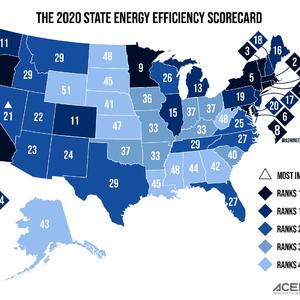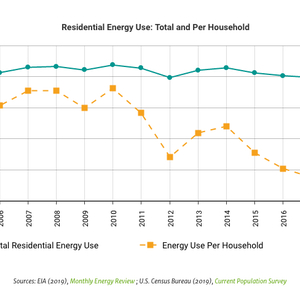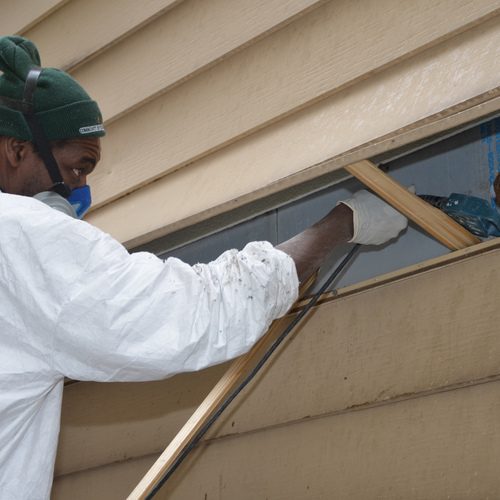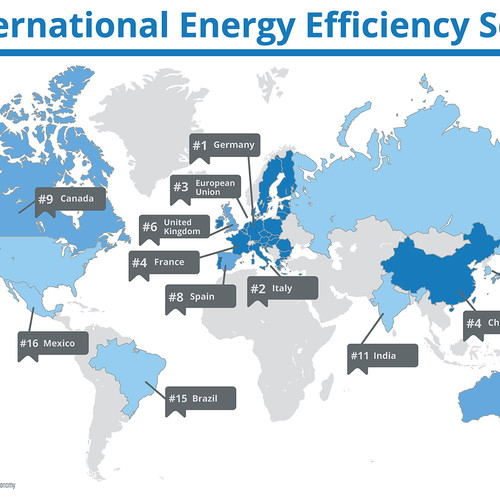
Have you ever seen one of those big yellow cards on refrigerators, washing machines and other new appliances? These government-mandated notices indicate about how much energy the average U.S. consumer will save by replacing their older model at home with one of these shiny new things.
Trouble is, different people use their appliances very differently — so most of us aren’t average consumers.
When we researched how behavioral differences varied, we found that Americans use vastly different amounts of energy to light our homes, watch TV, and make toast. As a result, we determined that the money and carbon pollution that can be saved from swapping out inefficient televisions and dryers for more efficient ones depends above all on what kind of consumer is buying.
Consumers have different expectations
The biggest driver of how much money consumers can save by using more efficient appliances is their behavior. For example, 14% of the population either watches TV or leaves their television on for an average of 7.7 hours per day, while half of Americans watch only an hour a day.
And while 45% of U.S. households do laundry between two and four times every week, 10% of us are running between 10 and 15 loads. Another 8% use their washers and dryers once a week or less.
If you don’t use an efficient appliance very often, it’s harder to get the savings needed to compensate for the cost of buying it. For example, a standard top-loading washing machine that is about $200 cheaper than an efficient model that uses up to 50% less energy. To justify the more efficient model, a consumer wants to save more than the extra $200 sticker price in their utility bills before replacing the appliance, typically about 11 years later.
We found that a household’s bottom line for buying a high-efficiency washing machine versus a standard one ranged from a $100 loss to saving $1,560. Where you might land on this spectrum depends on how many loads of laundry you and yours do every week and to a lesser extent, where you live.

With this big a range, knowing the average savings isn’t much help when you’re deciding whether to spend the extra money on an efficient model.
For some appliances, however, behavior plays a smaller role. Unless you hold your refrigerator door open for hours at a time, it probably costs you the same amount to run it as it would in anyone else’s home.
Demographics, behavior and geography
Demographics play a big role. Heavy television watchers tend to be elderly and retired. Families that constantly do laundry usually have little kids.
Personal preferences matter as well. For example, two single people with similar jobs may watch different amounts of television depending on how they spend their free time.
It also matters how much you pay for electricity and natural gas, which depends on where you live.
For instance, the average U.S. residential electricity rate in 2017 was about 13 cents per kilowatt-hour, the energy it takes to power a laptop for two or three days. But in Washington state, a kilowatt-hour costs less than a dime, while people in Hawaii had to pay 29.5 cents per kilowatt-hour — making it the most expensive state for ratepayers.
Likewise, the environmental benefits of energy-efficient appliances varies from place to place.
When consumers need less electricity, local utilities don’t have to generate as much of it. Ratcheting down production at a coal plant will reduce a lot of carbon emissions, while turning down a hydropower plant won’t because it doesn’t emit carbon to begin with.
The benefits of using less energy to do your laundry for society and the planet depend, therefore, on how your region is generating electricity. When we calculated this effect using real-world data, we found, for example, that saving the same amount of energy in coal-dependent Pennsylvania reduced 4.4 times more carbon than in hydropower-rich Washington state.
Getting better energy info
Based on our findings, we believe that the government and utilities should pay more attention to the many differences between consumers, including where they live, to make the most of their efforts to increase appliance efficiency.
For example, we calculate that families with three or more kids save on average $570 from an efficient washer before replacing it, and 25% of them save more than $1,000. These families have a bigger incentive to buy an efficient washer compared to an average consumer, who would only save $125.
Getting a good estimate for how much they personally will save could influence and expedite their decision to upgrade their laundry room.
Ensuring that the public has this information could also help the environment. The consumers who would save the most money are also the ones who can potentially reduce their carbon emissions the most by using more efficient appliances.
Making it happen
We also see some straightforward ways to make this happen.
First, consumers should be able to find out what their own potential energy savings would be. Tailoring this information could be accomplished relatively easily with a simple app for use by customers and sales staff. Apps like these are already helping homeowners see how much money they might save in the long run from installing rooftop solar panels.
Utility rebate programs can also be improved with a more personalized approach. Many utilities will offer money back if their customers buy an efficient appliance. Utilities could encourage larger savings by targeting the kind of people likely to save more with an efficient appliance.
In addition to the yellow energy use labels, the U.S. government also runs the Energy Star program, which certifies efficient appliances. Despite coming under attack from the Trump administration, these programs have been low-cost and effective ways to promote energy efficiency.
But personalized information has potential to take promoting energy efficiency to the next level.
It’s one of those everybody-wins situations: Utilities will save more energy and customers will save more money. With carbon emissions declining more swiftly, the whole world benefits as some progress will be made toward slowing the pace of climate change.
Eric Williams is professor of sustainability at the Rochester Institute of Technology. Ashok Sekar is a postdoctoral fellow with the Energy Systems Transformation Research Group at the University of Texas at Austin. Eric Hittinger is associate professor of public policy at the Rochester Institute of Technology. This post originally appeared at The Conversation.
Weekly Newsletter
Get building science and energy efficiency advice, plus special offers, in your inbox.














12 Comments
While your not wrong most people replace appliances when they die.
If the up charge for the extra efficiency is not much then the savings are quicker.
My washing machine was usable but unrepairable (i had to stop-start it 1-4 times a load), i upgraded to a high efficiency model and cut my water usage in half. Electricity usage interestingly stayed about the same or maybe even rose slightly (tested by a kill a watt) even though the new unit is maybe 20 years newer.
I would welcome such an app, a database of electricity usage by appliance per unit of use compared to a replacement would be awesome. But putting together such a database would be a fair amount of work and a high variability of items to catalogue
All that said washing machines and dryers under say 30 years old are not going to have a lot of gains in electricity usage. While i am extrapolating from my limited experience my 20 year old unit used 380Wh/load and 190L of water and the new unit ~300W a load and 250Wh/month of phantom load (!) and 80-90L of water per load. I have read some front loaders can use as little as 30L of water per load but its hard to imagine the amount of electricity is less. Dryers are about the same they all use comparable amounts of electricity and the savings available are small.
The number of loads matters more then the energy usage per load. This may be what we need to focus our efforts on
The heat pump dryers do use 25-50% less though mine varies per load even when they are about the same so i consider it a 25-33% savings but they cost far more then the energy it will probably ever save in its lifetime.
Fridges/freezers./AC/dehumidifiers is where the money savings are. Old units were huge hogs and new units are misers.
Oh and induction stoves.
Since this article is not a GBA exclusive are the authors going to read our comments?
There's a significant portion of the population who regularly replace their appliances for aesthetics alone. Every 5 years or so, the colour and style of appliances are deemed tacky and hideous. So new ones get bought, the old ones are sent to the landfill or given away, signalling the beginning of the next 5 year cycle.
I have yet to meet anyone who has done this. Most everyone i have ever known to replace an appliance has done so because of failure. Some just replace instead of looking to repair and some replace when the repair person tells them a single obsolescence failed part costs almost as much or even more then a new machine after labour.
So you will have to excuse me if i don't believe this.
But even if you were somehow correct that means they are likely up to date on water efficiency anyways assuming they buy a top load HE or front load model. And if i had that kind of money to regularly waste i would be spending it much more wisely.
Hello vacation!
I personally have known several people who replaced every kitchen and bathroom appliance in their house in one shot because they decided they didn't like the colour anymore. They all relay this story as if it was the most natural thing in the world to do.
I've also bought several used appliances. Every single one was being sold because they did a remodel of some kind, and the appliance either didn't fit in with the decor, or no longer matched some other appliance.
The manufacturers are well aware of this, and frequently come up with new looks and finishes to try to encourage the behaviour. Once, white appliances were the norm. Then weird colours like avocado became the in thing. Then everyone decided those were bad, so white was in style again. Once stainless steel finishes came out, white appliances were seen to be junk that only a poor person or a weirdo would have. Now they have a different shade of stainless steel, slate or something. I'm pretty sure if you polled people on what factors affected their appliance purchase decisions, appearance would be number one, followed closely by price. After that would be features and gadgetry. A distant fourth might be efficiency. This is for the average person, obviously the readers of this site are mostly in a different section of the Venn diagram.
You make a point that people who remodel their kitchen replace those appliances even if they are not dead.
However thats not the majority, i can think of many failure replacements and only and only a handful of remodel ones. And i can't remember anyone who remodeled their laundry room just to replace appliances.
And air conditioners also i can't imagine people replacing because of a remodel. If it got damaged and failed thats a different story though i can't recall a personal instance of that.
Alan,
Here's what I wrote about energy-efficient washing machines in my 2014 article on the topic ("All About Washing Machines"):
"Energy Star clothes washers use the same amount of electricity as clothes washers that don’t have an Energy Star label. 'Unlike other energy-efficient appliances, efficient clothes washers use about the same amount of energy as standard models. They save energy by using less water to wash clothes, and by removing more water at the end of the wash cycle, thereby allowing for shorter dryer cycles.'
"Energy Star washing machines may not save much electricity, but they do save water: 'The average Energy Star machine used 55% less water than the average non-Energy Star machine.'”
Cool.
Always nice when real life experience jibes with what an expert writes :)
Also its interesting about the phantom power you mention, mine is about 1 load a month equivalent so lower then the number you stated but i don't see how so much waste is necessary.
In discussing the efficiency of washing machines, it's important to see the washer and dryer as a pair. The clothes dryer is the energy hog of the two.
Top loaders are slow spinning and leave more water in the clothes, taking longer and more energy to dry. Front loading dryers use less water and spin the clothes fast enough to extract more water.
Studies have found a wide difference in dryer efficiency based on conventional vented dryer technology. "The difference in energy consumption is about 0.76 kWh per load or nearly 5,000 kWh over the typical 16-year useful life," found a report in the ACEEE Summer Study on Energy Efficiency in Buildings, "Are We Missing Energy Savings in Clothes Dryers?" by Paul Bendt, Ecos.
Looking into ventless dryer systems, the savings per load can be approximately 3.5 kWh per load. Venting removes conditioned air from the home that is replaced by cold or hot air depending on the season and location.
I live in PEI Canada where heating starts in September and ends in June with obviously the most heating in November to March. Vented dryers use between 6.3 kWh (0 F.) and 3kWh (80 F.). Ventless heat recovery dryers use 3.7 kWh to 2.5 kWh. At the mean temperature of 42 F. a ventless dryer uses 2 kWh less per load. At 7 loads a week, $.169/kWh = $123 a year in savings.
The new Whirlpool ventless dryer cost a few hundred more than a conventional dryer with the same features. This is a theoretical saving offset by higher maintenance costs. So far it has need a $100 annual service call to clean an inner lint filter on the condenser/heat exchanger, that Whirlpool didn't engineer for maintenance. That was probably because they are new to the ventless market.
European ventless dryers from companies like Bosch are smaller in capacity, more efficient and have user serviceable condenser filters.
I was curious how much energy different items in our house consumed, even when not in use, that I bought one of those Kill-a-watt meters on eBay. There was one reading that made me change my behavior. We don't watch a ton of TV, but we have the audio routed to a stereo amplifier with decent sized speakers to get some nice sound. We always turn off the TV when not in use, but usually left the amplifier running. Turns out it burns 27 Watts even when it has no sound input (I think this may be typical of stereo amps). This is about 19kWhrs per month. That's about 230 kWhrs per year, or currently about $25 of electricity totally wasted. Now I'm in the habit of turning off the stereo amp along with the TV.
I resisted venting our dryer through the wall for years. I recuperated the heat and humidity but couldn't manage to remove all the dust, and the wet laundry smell. I wonder if the ventless ones produce enough heat (without the smell of laundry) to justify not only their use (as compared to airdrying on a rack) but also their purchase price.
How did you recuperate the humidity?
I vented it to the cellar near the hot air furnace through a box with a filter.
Log in or create an account to post a comment.
Sign up Log in